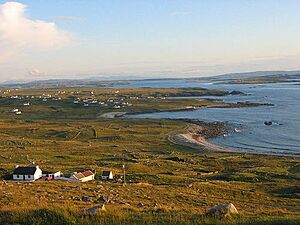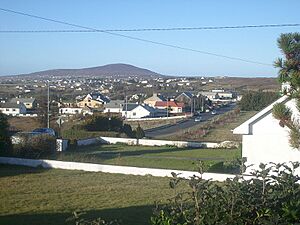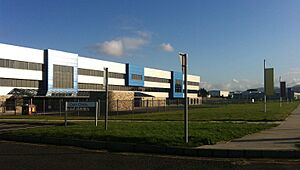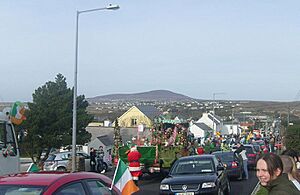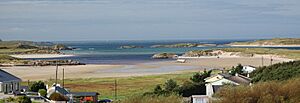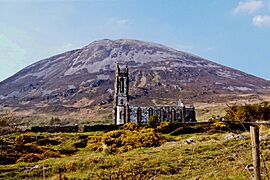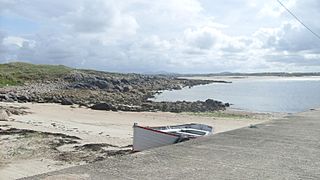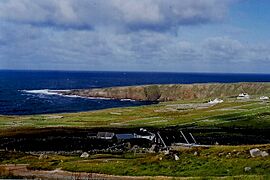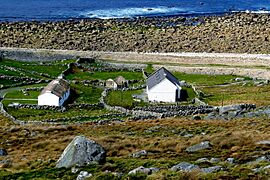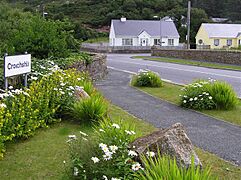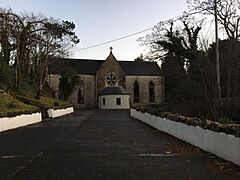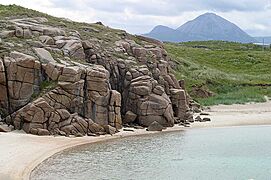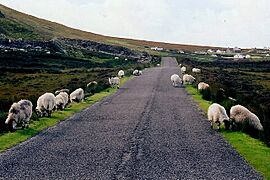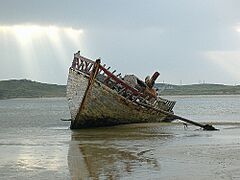Gweedore facts for kids
Quick facts for kids
Gweedore
|
|
|---|---|
|
District and parish
|
|
| Gaoth Dobhair (Irish) | |
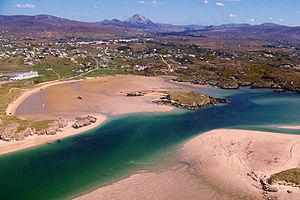
An aerial view of Gweedore, with Errigal and Magheraclogher Beach
|
|
| Country | Ireland |
| Province | Ulster |
| County | County Donegal |
| Population
(2003)
|
|
| • Total | 4,065 |
| Time zone | UTC+0 (WET) |
| • Summer (DST) | UTC-1 (IST (WEST)) |
| Area code(s) | 074 95, +000 353 74 95 |
| Irish Grid Reference | B847228 |
Gweedore (pronounced gwee-DOR) is officially known by its Irish language name, Gaoth Dobhair. It is a special Irish-speaking area called a Gaeltacht. Gweedore is located on the Atlantic coast of County Donegal in the northwest of Ireland.
This district stretches about 16 miles (26 km) from north to south and 9 miles (14 km) from east to west. It is sometimes called one of Europe's most populated rural areas. Gweedore is the largest Irish-speaking parish in Ireland, with about 4,065 people. It is home to the Irish-language radio station RTÉ Raidió na Gaeltachta and a campus of the University of Galway. Gweedore includes towns like Brinlack, Bunbeg, Derrybeg, Crolly, and Dunlewey. It sits near County Donegal's highest mountain, Errigal.
Gweedore is famous for its Irish culture. Old Irish customs, traditional music, theatre, Gaelic games, and the Irish language are very important to the local people. This, along with its beautiful scenery and many beaches, makes Gweedore a popular place for tourists. Many visitors come from Northern Ireland. Gweedore and its nearby areas, Cloughaneely and the Rosses, are known as "the three parishes." They form a unique social and cultural region, with Gweedore being the main center for social life and businesses.
Contents
- What Does Gweedore Mean?
- Language Spoken in Gweedore
- History of Gweedore
- Economy and Jobs
- Education in Gweedore
- Natural Features of Gweedore
- Getting Around Gweedore
- Sports in Gweedore
- Arts and Culture
- Religion in Gweedore
- Media and Radio
- Gallery
- Place Names in Gweedore
- Islands Near Gweedore
- Famous People from Gweedore
- See also
What Does Gweedore Mean?
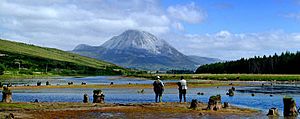
The name Gweedore comes from the original Irish name Gaoth Dobhair. Gaoth means an inlet of the sea at the mouth of the Crolly River. This inlet is called An Ghaoth. It marks the border between Gweedore to the north and The Rosses to the south. Dobhar is an old Irish word for water. So, Gaoth Dobhair means "the watery estuary" or "the estuary of water."
The name Gweedore refers to the whole traditional district and Catholic parish. It does not mean one specific village. The towns of Brinlack, Bunbeg, Derrybeg, Dunlewey, and Crolly, along with other areas like Meenaleck, Dore, and Magheraclogher, are all part of Gweedore.
Language Spoken in Gweedore
Gweedore has about 4,500 people and is divided into three areas called electoral divisions (EDs):
- Machaire Chlochair: This area has 2,651 people, and about 77% of them are native Irish speakers.
- Cnoc Fola/Mín an Chladaigh: This area has 1,326 people, and about 83% of them speak Irish.
- Dún Lúiche: This area has 695 people, and about 76% of them speak Irish.
The main language spoken in Gweedore is Irish, but many people also speak English. All schools, church services, and advertisements use Irish. Thousands of students from all over Ireland come to Gweedore every summer. They attend summer schools like Coláiste Cholmcille and Coláiste Bun an Inbhir to learn more about the Irish language. Gweedore is a Gaeltacht, which means Irish is the first language here. This keeps a strong connection to Ireland's long history and culture.
Most people in Gweedore speak both Irish and English. Because of this, you might hear English words used in an Irish sentence, and vice versa. This mix of languages has created unique words and phrases. For example, the Irish ending -ailte or -eáilte is used to make English verbs sound Irish, like wreckailte for "tired."
History of Gweedore
In 1609, the Plantation of Ulster brought big changes to the area. Irish-speaking families were forced to leave their good lands and moved to the poor boglands of west Donegal. Some of them reached Gweedore and could not go any further west. Around the same time, English and Scottish settlers arrived. It seems Gweedore was not very populated until the 17th century. The first people lived on the islands or near the shore in small groups of houses. Until the early 1800s, the population was small, and people got along well with the landowners.
Life became harder in the 19th century when new landlords arrived, especially Lord George Hill and his son Arthur. The local people, led by James McFadden, who was the parish priest from 1875 to 1901, stood up to the landlords. They formed groups like the Irish National Land League to fight for their rights. A major event was the killing of a police officer, William Limbrick Martin, outside the local church in Derrybeg on February 3, 1889. This event was part of the Land War in Gweedore. Many people were arrested after this. The story was later told in the memoirs of Tim Healy, who defended Father McFadden and the local people.
An Irish American journalist, W.H. Hurlbert, also wrote about the landlord-tenant problems in Gweedore in his book Ireland under Coercion in 1888. Many books have been written about Gweedore's history, in both Irish and English. Cáit Nic Giolla Bhríde was a well-known local historian.
Big Storm in Gweedore
On June 23, 2009, a very strong thunderstorm hit Gweedore. It was mainly in Bunbeg and Derrybeg and lasted for several hours. Two rivers overflowed, flooding homes, shops, and factories. Roads were ripped up, and bridges were destroyed. Lightning damaged power lines and caused mobile phone service to stop. People trapped by the floods could not call for help. Up to 20 houses were cut off because three bridges were washed away by the swollen rivers.
People called it the worst storm "in living memory." It was also the most severe since 1880, when five people drowned in Derrybeg. The storm was very local, so rain gauges missed the heaviest rainfall. However, Met Éireann estimated that up to 600 mm (24 inches) of rain fell in the main area between 2 pm and 6 pm.
Economy and Jobs
In the 1980s and 1990s, Gweedore had many factories. About 20 large companies made things like rubber, carpets, and cleaning products. But by 2001, most of these companies closed because of competition from other countries. About 4,000 jobs were lost, which greatly affected Gweedore and nearby areas. The factory in Crolly has been making porcelain dolls called Crolly Dolls since 1939. In 2003, the area was renamed Páirc Ghnó Ghaoth Dobhair (Gweedore Business Park). The Gaeltacht group, Údarás na Gaeltachta, started trying to attract new businesses to help the local economy. A Scottish company opened a call centre there, but it later closed.
Other businesses in Gweedore include supermarkets, convenience stores, beauty salons, hairdressers, garages, pharmacies, pubs, cafes, and three hotels: Derrybeg Hotel, Teach Jack, and An Chúirt (Gweedore) Hotel.
Education in Gweedore
Primary Schools
All five primary schools in Gweedore teach in Irish. Children do not learn English until they are in senior infants (around 5–6 years old).
- Scoil Chonaill, Bunbeg (An Bun Beag)
- Scoil Mhuire, Derrybeg (Doirí Beaga)
- Scoil Phádraig, Dore (Dobhar)
- Scoil Bhríde, Mín an Chladaigh
- Scoil Adhamhnáin, Lunniagh (Luinneach)
Second-Level School
The only community school (for older students) is Pobalscoil Ghaoth Dobhair. It opened in Lunniagh in 1977. Like the primary schools, all subjects are taught in Irish, and most students take their exams in Irish.
Third-Level Education
In 2004, University of Galway opened a campus in Gweedore called Acadamh na hOllscolaíochta Gaeilge. It offers college-level education in Irish to over 80 students each year. Students can earn different diplomas and a new bachelor's degree in business studies.
Natural Features of Gweedore
Gweedore is close to Errigal, the tallest mountain in County Donegal. Errigal overlooks the beautiful Dunlewey Lough. The area has deep glens and lakes, like the Poisoned Glen, where the Cronaniv Burn flows. Further away are Glenveagh national park and castle, which is the largest national park in Ireland. Bád Eddie ("Eddie's Boat"), also called the Cara na Mara ("Friend of the Sea"), is a famous shipwreck on Magheraclogher Strand. It ran aground because of rough seas.
The Crolly River (Irish: Abhainn Chroithlí), also known as the Gweedore River, and the Clady River (Irish: An Chláidigh) are two main rivers in Gweedore.
The Gweedore coastline has long sandy beaches and rocky cliffs. There are also small islands nearby, such as Gola Island and Tory Island.
Getting Around Gweedore
Several bus companies operate from Gweedore, including Feda Ó Dónaill, Coyle's Coaches, and John McGinley. There is also a bus route that serves the local airport. For many years, the Lough Swilly Railway company provided a bus service that took people to places like Letterkenny and other nearby areas.
Gweedore is also close to Donegal Airport, which is located at Carrickfin, just west of Ranafast.
Old Train Services
Gweedore railway station opened on March 9, 1903. It stopped carrying passengers on June 3, 1940, and closed completely on January 6, 1947. The main engineer for the railway was Taggart Aston from Belfast. He designed and built many bridges for the Letterkenny to Burtonport Extension narrow-gauge railway (L&BER).
Sports in Gweedore
Local sports include Gaelic football, golf, and soccer.
Gaelic Games
The local Gaelic games club is CLG Ghaoth Dobhair. It is located in Machaire Gathlán and has facilities for all GAA sports. The Gaoth Dobhair senior team is very successful in the Donegal Senior Football Championship and Comórtas Peile na Gaeltachta. In 2018, they won the Ulster Senior Club Football Championship. Players like Kevin Cassidy and the McGee brothers (Eamon and Neil) are well-known for playing with the senior Donegal county football team. Newer players like Odhrán Mac Niallais, Kieran Gillespie, Michael Carroll, and Cian Mulligan have also joined the county team. Hurling was not very popular in Gweedore, except for a successful youth team in the late 1990s.
Golf
Gailf Chumann Ghaoth Dobhair, the local golf club, is also in Machaire Gathlán. The 14-hole course is along the beautiful northwest coast. It hosts several big tournaments each year, including 'The Clannad Classic,' sponsored by the famous local band Clannad.
Soccer
Soccer clubs in the area include Gweedore Celtic, Gweedore United, Glenea United, and Dunlewey Celtic. All these teams play in both county and national competitions. Scottish soccer player Paddy Crerand's mother was from Gweedore. He still visits often and even broadcast his show The Paddy Crerand Show live from the Ostan Gweedore Hotel in March 2012. Aiden McGeady's grandparents on his father's side are also from Gweedore, and he spent many summer holidays there.
Currach Racing
Cumann na gCurach is a group based in Machaire Gathlán. They organize currach (traditional Irish boat) races and take part in many races across the country.
Arts and Culture
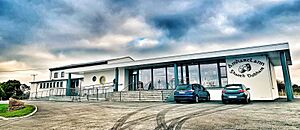
Music Scene
Gweedore is famous for its traditional Irish music. You can often hear it in local pubs. Many well-known musicians come from Gweedore. Clannad formed in 1970 and have sold over 15 million records. The lead singer, Moya Brennan, also has a successful solo career and has made music for Hollywood films. Altan, another very successful local band, is led by Mairéad Ní Mhaonaigh, a fiddler from Coshclady. Gweedore's most famous musician is Enya, whose real name is Eithne Ní Bhraonáin. She first performed in Amharclann Ghaoth Dobhair as a member of Clannad. She then became one of the world's best-selling artists, selling over 80 million records. Other local singers include Aoife Ní Fhearraigh, Brídín Brennan, Na Casaidigh, Proinsias Ó Maonaigh, Gearóidín Bhreathnach, Seamus McGee, and Maria McCool. The 1970s group Skara Brae also had strong ties to the area. There are two active choirs: Cór Mhuire Doirí Beaga and Cór Thaobh 'a Leithid. Both have recorded successful albums.
The song "Gleanntáin Ghlas' Ghaoth Dobhair" was written by local musician Francie Mooney. It is about someone leaving Gweedore and saying goodbye to its green valleys. It has become a modern Irish classic and has been sung by artists like Clannad, Paul Brady, and Altan. Other well-known songs from the area are "Trasna na dTonnta" and "Báidín Fheilimí".
Festivals and Events
The popular Scoil Gheimhridh Frankie Kennedy ("Frankie Kennedy Winter School") took place in Gweedore every New Year until 2014. It was held in memory of Belfast musician Frankie Kennedy. It has been replaced by the Scoil Gheimhridh Ghaoth Dobhair ("Gweedore Winter School").
Recently, there have been efforts to bring back summer festivals, such as Féile Earthcore and Féile Ceoil Ghaoth Dobhair. The yearly Saint Patrick's Day Parade, which goes from Bunbeg crossroads to Derrybeg, attracts thousands of people every year.
Theatre and Drama
Gweedore has a long history of theatre and drama. The local theatre, Amharclann Ghaoth Dobhair, was built in 1961. A local theatre group called Aisteoirí Ghaoth Dobhair ('actors of Gweedore') started in 1932. Their first play was In Aimsir an Mháirtínigh, an original play by Eoghan Mac Giolla Bhríde. It was performed in the parish hall in Derrybeg. Their plays and pantomimes, all in Irish, became a big part of Gaeltacht social life. People came from as far as Belfast to see them, and they performed all over Ireland and Scotland. Members of the group have gone on to create TV shows and appear on Ros na Rún. Many of Gweedore's musicians were also part of this group. Aisteoirí Ghaoth Dobhair is still active and has performed at An Grianán Theatre in Letterkenny.
Art Galleries
Gaoth Dobhair has two art galleries that show work by some of the area's best painters. An Clachán says it is the largest art gallery in Donegal. An Gailearaí at Áislann Ghaoth Dobhair has shown exhibitions of work by the famous painter Derek Hill.
Religion in Gweedore
The Roman Catholic parish of Gweedore has four churches: Teach Pobal Mhuire (St Mary's) in Derrybeg (built in 1972), Teach Pobail an Chroí Naofa (Sacred Heart) in Dunlewey (built in 1877), Teach Pobail Naomh Pádraig (St Patrick's) in Meenaweel (built in 1938), and Séipéal Cholmcille (St Columba's) in Bloody Foreland (built in 1933). The only Protestant church in Gweedore is St Patrick's Church of Ireland, in Bunbeg.
Media and Radio
The regional studios for the Irish language radio station RTÉ Raidió na Gaeltachta are in Derrybeg. Two radio shows are broadcast from Gweedore every day, along with regional news every hour.
Gallery
- Images of Gaoth Dobhair
Place Names in Gweedore
Because Gweedore is in the Gaeltacht, only the original Irish versions of place names are legally recognized. These are used on road signs. However, English versions were created for most names and are still commonly used informally.
Alphabetical List of Place Names
- Áit an tSeantí (Attantantee)
- An tArd Donn (Arduns)
- Ard na gCeapairí (Ardnagappery)
- Baile an Droichid (Ballindrait)
- An Baile Láir (Middletown)
- An Bun Beag (Bunbeg)
- Bun an Inbhir (Bunaninver)
- Bun an Leaca (Brinlack or Brinaleck)
- An Charraig (Carrick)
- Carraig an tSeascain (Carrickataskin)
- An Chorrmhín (Corveen)
- Cnoc an Stolaire (Knockastolar)
- Cnoc Fola (Bloody Foreland)
- Coitín or An Choiteann (Cotteen)
- Croichshlí or Croithlí (Crolly)
- Dobhar (Dore)
- Na Doirí Beaga or Doire Beag (Derrybeg)
- Dún Lúiche (Dunlewey)
- Glaise Chú (Glasserchoo)
- An Ghlaisigh (Glassagh)
- Gleann Tornáin (Glentornan)
- Gleann Ualach (Glenhola)
- An Luinnigh (Lunniagh)
- Loch Caol (Loughkeel)
- Machaire Chlochair (Magheraclogher)
- Machaire Gathlán (Magheragallon or Magheragallen)
- Machaire Loisce (Magheralosk)
- Mín an Chladaigh (Meenacladdy)
- Mín a Loch (Meenalough)
- Mín an Iolair (Meenaniller)
- Mín na Cuinge (Meenacuing)
- Mín Uí Bhaoill (Meenaweel)
- Mín Doire Dhaimh (Meenderrygamph)
- Muine Dubh (Meenaduff)
- Na Machaireacha
- Port Uí Chuireáin (Curransport)
- An Rampar
- An Screabán
- An Seascann Beag (Sheskinbeg)
- An Sloitheán (Sleghan)
- Srath Máirtín (Stramartin)
- Srath na Bruaí (Stranabooey)
- Srath na Corcrach (Stranacorkra)
- An Tor (Torr)
Rivers in Gweedore
- Abhainn Chró Nimhe (Cronaniv Burn)
- Abhainn Dhuibhlinne (Devlin River)
- An Chláidigh (Clady River)
Islands Near Gweedore
- Gabhla (Gola)
- Inis Meáin (Inishmeane)
- Inis Oirthear (Inishsirrer)
- Inis Sionnaigh (Inishinny)
- Umthoinn (Umpin )
-
- Toraigh (Tory), although it's not right off the Gweedore coast, the main ferries to Tory Island leave from this area.
Famous People from Gweedore
Here is a list of well-known people from Gweedore:
- Moya Brennan (born 1952) – musician and singer (also from the band Clannad)
- Enya (born 1961) – musician and singer
- Brídín Brennan (born 1968) – musician and singer
- Mairéad Ní Mhaonaigh (born 1959) – musician and singer
- Cormac Breslin (1902–1978) – a politician who was a Fianna Fáil TD and Ceann Comhairle (Speaker of the Dáil)
- Kevin Cassidy (born 1981) – Gaelic footballer and All-Star player
- Breandán de Gallaí (born 1969) – a former lead dancer with Riverdance
- Pearse Doherty (born 1977) – Sinn Féin TD (a politician)
- James Duffy (1889–1969) – received the Victoria Cross for bravery
- Rónán Mac Aodha Bhuí (1970-2023) – a radio personality
- Seán Mac Fhionnghaile (1952–2009) – an actor
- Kevin Gillespie (born 1972) – a Catholic priest
- Tarlach Mac Suibhne (1831–1916) – a musician
- John McCole (1936–1982) – a soccer player; born in Glasgow but buried in Gweedore, where his parents came from
- Na Mooneys - a family folk band
- Neil McGee (born 1985) – an All-Ireland winning Gaelic footballer and All-Star
- Eamon McGee (born 1984) – an All-Ireland winning Gaelic footballer
- Dinny McGinley (born 1945) – a former Fine Gael TD and Minister of State
- Odhrán Mac Niallais (born 1992) – Gaelic footballer
- Francie Mooney (1922–2006) – a musician
- Na Casaidigh, a traditional Irish band
- Natasha Nic Gairbheith (born 1981) – Miss Ireland 2004
- Aoife Ní Fhearraigh - a singer
- Patrick O'Donnell (1835–1883) – an Irish Republican
- Gavin Ó Fearraigh (born 1980) – an actor and model
- Bríd Rodgers (born 1935) – a SDLP politician and Member of the Legislative Assembly for Upper Bann.
See also
 In Spanish: Gweedore para niños
In Spanish: Gweedore para niños




